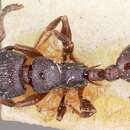Taxonomic History
provided by Antweb
Xiphomyrmex severini Emery, 1895g PDF: 343 (w.) MADAGASCAR. Malagasy. Primary type information: MADAGASCAR, Diego Suarez, 1893, coll. C. Allaud; CASENT0102078; MSNG
AntCat AntWiki HOLTaxonomic history
Combination in
Tetramorium:
Bolton, 1979 PDF: 138.See also
Hita Garcia & Fisher, 2014c PDF: 157.
- bibliographic citation
- AntWeb. Version 8.45.1. California Academy of Science, online at https://www.antweb.org. Accessed 15 December 2022.
Description
provided by Zookeys
Head distinctly longer than wide (CI 92–96); posterior head margin weakly concave. Anterior clypeal margin with distinct median impression. Frontal carinae strongly developed, diverging posteriorly, and usually ending shortly before posterior head margin; antennal scrobe present, but weak, shallow, and without defined posterior or ventral margins. Antennal scapes short, not reaching posterior head margin (SI 69–78). Eyes of moderate size (OI 22–24). Mesosomal outline in profile flat, relatively low and elongated (LMI 35–37), only weakly marginate from lateral to dorsal mesosoma; promesonotal suture and metanotal groove usually present, but relatively weak. Propodeal spines very long, spinose, and acute (PSLI 38–43); propodeal lobes short, triangular, and blunt, always much shorter than propodeal spines. Petiolar node in profile high, rounded nodiform, with well-rounded antero- and posterodorsal margins, around 1.5 to 1.7 times higher than long (LPeI 57–69), anterior and posterior faces approximately parallel, generally anterodorsal and posterodorsal margins situated at about same height (sometimes anterodorsal margin higher than posterodorsal margin), petiolar dorsum always noticeably rounded and convex; node in dorsal view around 1.1 to 1.2 times wider than long (DPeI 104–121), in dorsal view pronotum between 2.4 to 2.8 times wider than petiolar node (PeNI 35–41). Postpetiole in profile globular to subglobular, approximately 1.1 to 1.3 times higher than long (LPpI 79–91); in dorsal view between 1.0 to 1.2 times wider than long (DPpI 103–117), pronotum around 1.8 to 2.1 times wider than postpetiole (PpNI 47–54). Postpetiole in profile usually appearing thicker and slightly lower than petiolar node, postpetiole in dorsal view between 1.2 to 1.4 times wider than petiolar node (PPI 125–143). Mandibles variably sculptured, ranging from fully unsculptured, smooth, and shining, through partially striate, especially basally, to fully covered by fine striae; clypeus longitudinally rugose/rugulose, with four to eight rugae/rugulae, median ruga always very well developed and distinct, lateral rugulae usually much weaker and usually broken; cephalic dorsum between frontal carinae with seven to nine thick, longitudinal rugae, rugae running mostly unbroken from posterior clypeal margin to posterior head margin, rarely interrupted or with cross-meshes; scrobal area usually mostly unsculptured, rarely longitudinally rugulose to reticulate- rugulose; lateral head longitudinally rugulose to reticulate- rugulose, often with unsculptured and smooth areas. Mesosoma laterally irregularly longitudinally rugose to reticulate-rugose; sculpture on mesosomal dorsum relatively weak, usually consisting of feeble, irregular longitudinal rugulae, often with unsculptured and smoother areas. Ground sculpture on head and mesosoma weakly to moderately punctate Forecoxae rugulose to reticulate-rugulose. Waist segments and gaster completely unsculptured, smooth. and shining. Head with numerous long, standing hairs, mesosoma with one or two long hairs, waist segments and first gastral tergite without any standing hairs at all; first gastral tergite with very short, moderately scattered, and appressed pubescence. Anterior edges of antennal scapes and dorsal (outer) surfaces of hind tibiae with appressed hairs only. Body very dark brown to black, appendages often slightly lighter.
- license
- cc-by-3.0
- copyright
- Francisco Hita Garcia, Brian L. Fisher
- bibliographic citation
- Hita Garcia F, Fisher B (2014) The hyper-diverse ant genus Tetramorium Mayr (Hymenoptera, Formicidae) in the Malagasy region taxonomic revision of the T. naganum, T. plesiarum, T. schaufussii, and T. severini species groups ZooKeys 413: 1–170
- author
- Francisco Hita Garcia
- author
- Brian L. Fisher
Distribution
provided by Zookeys
Tetramorium severini is widely distributed in the rainforests and montane rainforests of eastern and northern Madagascar (Fig. 66). The distribution ranges from Andohahela in the southeast to Montagne d’Ambre on the northern tip of the island, and from there south to Nosy Be, Ampasindava, and Manongarivo on the northwestern side. Throughout its distribution, Tetramorium severini is found at altitudes ranging from 25 to 1125 m. In addition, it seems that the species lives in leaf litter and/or the ground.
- license
- cc-by-3.0
- copyright
- Francisco Hita Garcia, Brian L. Fisher
- bibliographic citation
- Hita Garcia F, Fisher B (2014) The hyper-diverse ant genus Tetramorium Mayr (Hymenoptera, Formicidae) in the Malagasy region taxonomic revision of the T. naganum, T. plesiarum, T. schaufussii, and T. severini species groups ZooKeys 413: 1–170
- author
- Francisco Hita Garcia
- author
- Brian L. Fisher

